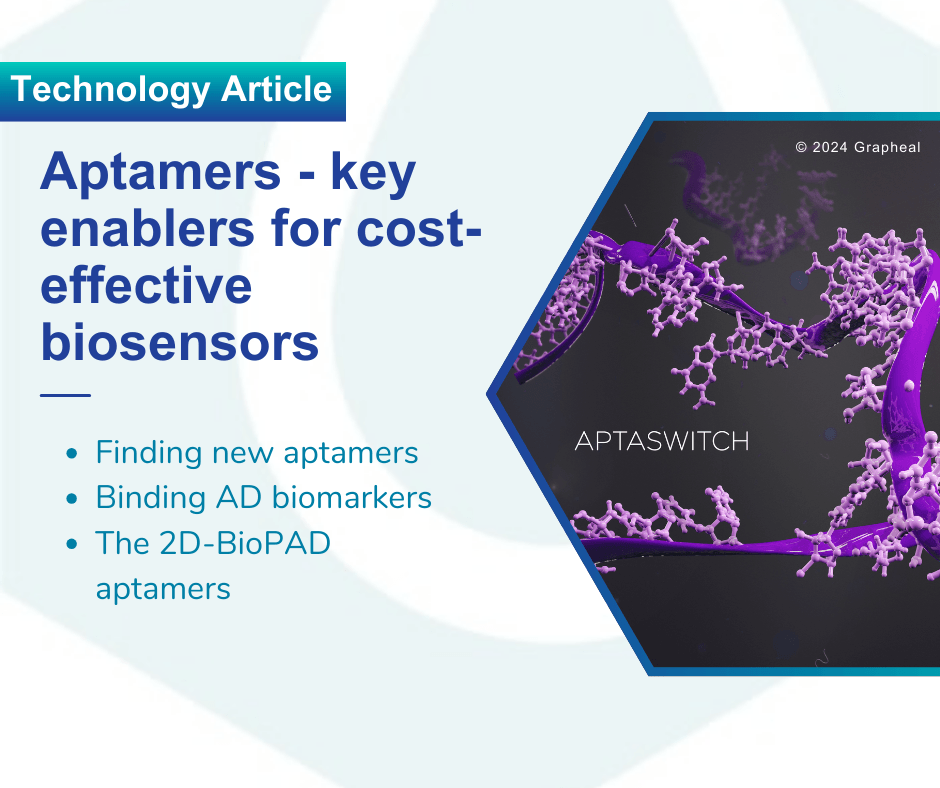
Aptamers are short single-stranded sequences of DNA or RNA that can form unique 3D structures like proteins (Figure 1). Primarily designed to mimic antibodies, these ‘chemical antibodies’ offer an alternative recognition element that have comparable affinities, are less expensive, have smaller molecular size[1], and are biocompatible. The aptamers have also added advantages over antibodies, such as high reproducibility owing to in-vitro production, and can also be generated against targets which are toxic in nature. Aptamers have also excellent specificity allowing them to even distinguish between different isoforms of a target (e.g., protein), while being more stable under harsh conditions.

Figure 1. Basic design of the electrochemical detection cell for paper-based microfluidic devices. WE, working electrode; RE, reference electrode; CE, counter electrode8
These advantages make aptamers ideal for targeting a range of analytes, rendering them a potent rival of antibodies in therapeutics and biosensing. Their remarkable binding affinities combined with facile synthesis and easy modifications have led to their extended use with various nanomaterials such as nanoparticles and graphene-based substrates. This has allowed the development of novel biosensors (i.e., aptasensors) with improved performance and wider commercial applications. Such biosensing devices hold immense value for low-cost solutions, especially for point-of-care in vitro detection (PoC IVD) systems.
Finding new aptamers - The selection process
Aptamers are identified in randomly synthesized oligonucleotide libraries of huge diversity through an in vitro experimental approach first described in the 90s and named Systematic Evolution of Ligands by Exponential Enrichment (SELEX)[2],[3]. It involves iterative cycles of oligonucleotide pools binding to the target, followed by the separation of the complexes formed, amplification of the bound oligonucleotides and their reintroduction into the next selection cycle. With each selection cycle selection parameters are made more stringent and, this process progressively enriches the population into molecules that have a high affinity for the intended target. Ultimately, this makes it possible to isolate aptamers that can recognize cognate target molecules with high specificity and affinity, including proteins, making them ideal probes or recognition elements for sensors, pathways inhibition, diagnostic applications, etc. Today, there exist multiple versions of this approach depending upon target/library, separation of complexes and experimental setup.
Binding Alzheimer’s Disease biomarkers
The first aptamers targeting Aβ peptides were reported in 2002[4]. Since then, a lot of studies have used aptamers to target biomarker proteins for dementia and AD. However, in most cases results cannot be reproduced, making it extremely difficult to identify aptamers that can effectively be employed for the design and fabrication of AD biosensors.
All literature findings, that have targeted Aβ1-40, Aβ1-42 and tau protein isoforms (such as p-tau231), claim to have superior performance over the conventional ELISA methods.
Delivering a multi-analyte biosensor – The 2D-BioPAD aptamers
Novaptech brings 30 years of aptamer research experience and specializes in the identification, optimization and development of aptamers, oligonucleotides capable of binding to diverse molecular/cellular targets with high specificity. Novaptech provides custom aptamer services for both selection of aptamers against desired targets and characterization of aptamers using standard methods such as surface plasmon resonance (SPR) and biolayer interferometry (BLI). The inhouse R&D program has allowed it to have a large collection of aptamers against diverse pools of targets including antibiotics, pesticides, etc. The subsequent applications of selected aptamers include ELISA-like assays, imaging applications, molecular beacons and the use of aptamers as therapeutics.
In 2D-BioPAD Novaptech will deliver custom aptamers that bind specifically and with high affinity to AD biomarkers (e.g., Aβ1-40, Aβ1-42, p-tau217, NfL, GFAP, etc.). These aptamers will be used as probes for the 2D-BioPAD biosensors, to allow a more cost-effective design of the envisioned PoC diagnostic aid.
The first set of aptamers against GFAP have been identified recently and, several selection processes are currently running against other targets. The next steps now include length optimisation of these aptamer sequences before proceeding with the actual conjugation with the magnetic nanoparticles and the integration with the electrochemical and GFET biosensors.
[1] Shui, B., Tao, D., Florea, A., Cheng, J., Zhao, Q., Gu, Y., ... & Guo, Z. (2018). Biosensors for Alzheimer's disease biomarker detection: a review. Biochimie, 147, 13-24.
[2] Tuerk, C., & Gold, L. (1990). Systematic evolution of ligands by exponential enrichment: RNA ligands to bacteriophage T4 DNA polymerase. science, 249(4968), 505-510.
[3] Ellington, A. D., & Szostak, J. W. (1990). In vitro selection of RNA molecules that bind specific ligands. nature, 346(6287), 818-822.
[4] Ylera, F., Lurz, R., Erdmann, V. A., & Fürste, J. P. (2002). Selection of RNA aptamers to the Alzheimer's disease amyloid peptide. Biochemical and biophysical research communications, 290(5), 1583-1588.